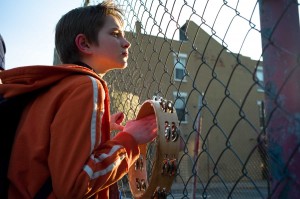
Editing is all about focusing attention on what the filmmakers want an audience to see at any given time in a film. The editing on Extremely Loud and Incredibly Close takes its focus from the book and adapted screenplay that were written from point of view of the lead character Oskar (Thomas Horn). Both mediums externalized the boy’s thoughts in voice over. Oscar winning editor Claire Simpson (Platoon), who had previously worked with director Stephen Daldry on The Reader, admits that the filmmakers “continued this device in the film.” What makes that decision even more interesting is the fact that the character has Asperger syndrome, a form of high functioning autism that makes those with the condition experience the world in different ways than most people.
In addition to the voice-over, to support the decision to tell the story from the boy’s point of view, the team used a form of tilt shift defocusing for the shots which were clearly from Oskar’s POV. “We selected a narrow point of focus within a shot and slightly defocused the area around that,” explained Simpson. “It has the effect of drawing the viewers eye to and concentrating directly on the point of focus. This was designed in postproduction, but had been discussed as a concept in pre-production.”
The biggest challenge editing the film was how much of the actual 9/11 news footage, if any, to include in the film and whether or not to use the disturbing image of “the falling man” that has become an icon of the tragedy. “Some viewers and critics have found the use of these images prurient,” said Simpson. “We agonized over this and discussed them at length with some of the parents and siblings of the victims of the 9/11 World Trade Center attack as well as support groups for the relatives of those victims.” After early private screenings with many of these groups the consensus was to not shy away from using them.
After seeing the film it is evident that the filmmakers took many true events to heart and incorporated them into the film. “The content of the answer machine messages was also a matter of concern,” revealed Simpson. “One sibling told of hearing a prayer group in the background of the final message that his brother left; one mother spoke of the generosity and thoughtfulness her son had shown at the hour of his death for his friends and family; others spoke of the fear and panic. One gentleman, whose son had died in the World Trade Center, heartbreakingly described the effects on his grandson – how many of the children of the victims obsess about whether their parent was ‘a jumper.’ They examine photographs downloaded from the Internet. Those who had no recovered body to bury, which is the vast majority, are left to imagine the unimaginable.”
“In the child, Oskar, we tried to express the pain of that catastrophic loss in particular,” shared Simpson. “Grief is universal. If we can understand the legacy of pain from this kind of catastrophic event then perhaps we will be less willing to allow it to be repeated anywhere.”





